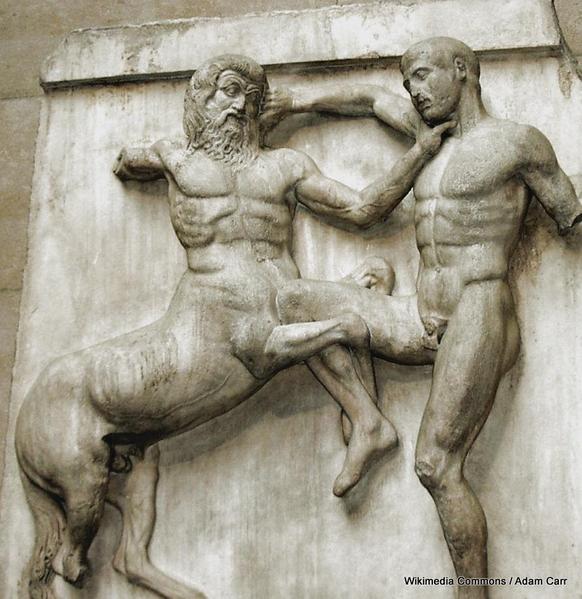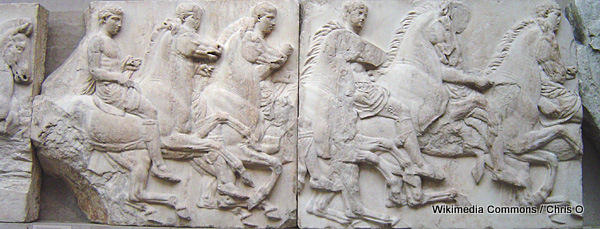The Parthenon, sitting in ruins atop the Acropolis in Athens, is arguably one of the world’s most famous landmarks, instantly recognizable to millions around the world. And yet, unlike such others as the Eiffel Tower or the Brooklyn Bridge, it barely resembles its origins. It’s been in ruins since a gunpowder explosion in 1687, and its partial restoration since then has been in fits and starts, and sometimes in error. Today, it is the ruins and not the buildings that we remember. But here’s a good guess as to what it may have looked like in its hey-day.
And it didn't get to its hey-day easily…you might think of it as one of those building projects that never seems to get done, complete with cost over-runs, disasters, wars and redesigns.
Of course, it’s not just the Parthenon up there: the Acropolis served as a civic, religious and defense center, although only a few of the buildings remain even as ruins. The complex also includes performance space…some restored enough to be used today.
We visited during a February week, with spring in the air and plenty of company. The visit began with a morning at the New Acropolis Museum, at the base of the hill, full of exhibits on the history of the Acropolis, construction techniques and thousands of artifacts. The museum itself is built over excavated ruins of the ancient neighborhood. Through the floor and open wells in a number of places you can see these remnants; archaeological work is still going on in them.
From the museum, there’s a long gently-sloping path up the hill to the top (although some like to take the steeper ways). It’s a pleasant walk, punctuated with benches and stopping points—and vendors selling delicious baked snacks. No fear! The walk to the top will take care of any calories…yeah, sure…
The path is also a favorite of Athens' dozing dogs. Dogs and cats roam freely in many parts of the city; no one seems to mind them.
At the top, starting at the huge entranceway, the Propylaea, the general impression is “immense.” Even up close where you can see the human dimensions of small areas, the overall sense is of monument and impression; where pieces of stone lie around waiting to be re-fitted, they seem massive. The modern crane being used in the work only adds to that.
The visit starts at the Propylaea, swarmed with tourists, and—as in so many other places in Athens—dogs sunning themselves without a care about the anxious humans rushing past them.
There’s evidence of human activity on the Acropolis as early as the late Bronze Age, perhaps to 6000 years ago. No buildings from then…just artifacts from the Myceneans. Like all good defenses, they started on the highest hill of what would become Athens, but little more is known about them.
The earliest really traceable buildings on the Acropolis (whose name identifies it as the highest point in the city) date to about perhaps 1300 BC and are associated with Cecrops, the legendary founder of Athens (and if myth is to be believed, half man and half serpent…much like modern politicians). He built a fortified palace, and just after his time the hill was surrounded with its first wall, large crude stones without mortar, and spaces between them filled with smaller stones, following the shape of the hill. Later construction has masked this first wall.
And so it remained until about 700 BC, when, after coups and counter-coups left Peristrata in charge, he improved his chances by building a new and stronger wall, especially protecting the corner where a deep well provides secure water. And, on the site of the Parthenon today, he built a large limestone temple, as well as the first version of the Propylaea, or entrance gate.
Around 570-550 (counting backwards in BC!) the Parthenon site was taken by a new temple to Athena, the city’s patron goddess. About 30 years later, another temple to Athena was built near this original (which the archaeologists call the “primitive-Parthenon&rdquo![]() . Then the primitive-Parthenon was dismantled to make way for the “pre-Parthenon,” which was built of limestone. At that point, the hill was evened off a bit by adding 8000 two-ton limestone slabs to extend the flat part. Yes…16,000 tons.
. Then the primitive-Parthenon was dismantled to make way for the “pre-Parthenon,” which was built of limestone. At that point, the hill was evened off a bit by adding 8000 two-ton limestone slabs to extend the flat part. Yes…16,000 tons.
The building was still under construction when Athenians won the battle of Marathon—and decided to celebrate by switching to marble instead of limestone. It was still under construction a few years later when Xerxes of Persia successfully invaded Athens and, in 480, looted and burned everything on the hill.
After all that, the site was swept clear of rubble, sacred objects buried in a deep grave, and all the remaining building material used to create a new, stronger wall on the north side. The burial site of the religious rubble, known as the “Persian Debris” has been an archaeologist's dream.
So…back to the classical drawing boards. Under the rule of Pericles, in the so-called Golden Age from around 460 to 430 BC, almost all the buildings we see on the Acropolis were constructed: the massively redone Propylaea, the Parthenon, and the Erectheion, which honors Athens' mythological kings and Poseidon, Athena’s rival for the city. Above, the Erectheion, with its caryatids taking the place of columns.
Of course, that’s far from the end of the history. As we've seen all over, conquerors recycle and rebuild. After Greece came under Rome’s control, some Roman statues and some Roman temples were added, and some buildings were rededicated to other gods. The Romans also built the amphitheatre, which was destroyed two centuries later, and only rebuilt in the 1950s. Athens’ Byzantine rulers turned the Parthenon into a cathedral, dedicated to the Virgin Mary, and moved the city’s administration back onto the hill, which was re-fortified.
After the fall of the Byzantine rule in the 15th century, Ottoman Turkish rulers used the Parthenon as army headquarters; when Venice laid siege to the city in 1687, attempting to seize it from the Turks, a round from Venetian artillery hit the building and set fire to gunpowder stored there—giving the building its modern ruined appearance. After the explosion and fire, the Ottomans built an entire mosque, with minaret, inside the ruins.
After Greek independence in 1821, national pride led to housecleaning: All remnants believed to be part of foreign rule—any foreign rule—were swept away, and attempts began to rebuild it “as it was.” Since there was little documentation, not a lot of scholarship and a great deal of enthusiasm, they got quite a bit wrong. Today’s restorers took a hint: all the work being done now uses a different color of marble to show what is old and what is new, and everything is being held together with titanium dowels so that it can be undone if future research comes up with different answers.
Greek pride in their heritage has left a long-open sore in relationships between Greece and Britain; in the 1830s, Lord Elgin removed significant marble sculpture from the building and shipped it to England, where it can be seen in the British Museum; for many years it was referred to as “the Elgin Marbles.” Britain refused for many years on grounds that Greece was not equipped to care for them; the building of the New Acropolis Museum was intended to answer that. But still they stay in Britain.
Two portions of the statuary removed from the frieze of the Parthenon by Elgin.
The Acropolis has played a part in more modern Greek pride and politics. Athens was occupied by German troops during World War II; they hung a large Nazi battle flag above the Parthenon. On the night of May 30, 1941, two young Greeks made their way up, and tore down the Nazi flag—one of the first public acts of Greek resistance. The Germans sentenced them to death in absentia—they were never caught. Ironically, both men served long terms in jail and in exile after the war because of their opposition to Greece’s right-wing postwar government. This plaque, at the flagpole, honors their act.
Of course, the Acropolis is not all there was of classical Athens, although it was the center of sacred and the symbol of the city. The remains of other temples and other buildings are scattered all over the city, most in ruins and few as well-preserved as this one, below the Acropolis and near the Agora, the commercial and judicial heart of ancient Athens.
From the Acropolis, a fairly-long and very winding path makes its way down the hillside to the Agora, and then beyond it to one of the modern-day hearts of Athens, Monastariki Square.
But from there, as from much of the city, the Parthenon and Acropolis are seldom out of view.
As ever: Too many pictures! Please enjoy these; they are more are in the slideshow below.
Old monastery and walls atop a hill across from the Acropolis
From the gift shop at the museum, you can take home your own Parthenon...
Documenting the documenter...
Only fair play to give the cats some time along with the dogs...
And there's always a bird picture, perched on ancient walls
Modern building in the background is the New Acropolis Museum







Comments (1)